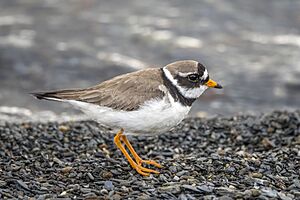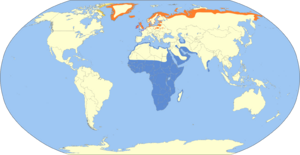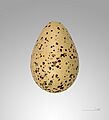Common ringed plover facts for kids
Quick facts for kids Common ringed plover |
|
|---|---|
 |
|
| Adult | |
| Conservation status | |
| Scientific classification | |
 |
The common ringed plover (also called the ringed plover) is a small bird. It belongs to the plover family. These birds live and have their babies across much of northern Eurasia and in Greenland.
The scientific name for this bird is Charadrius hiaticula. The first part, Charadrius, comes from an old Late Latin word. It was used for a yellowish bird mentioned in an old book called the Vulgate. This word came from an Ancient Greek word, kharadrios, meaning a bird found in rocky valleys or near rivers. The second part of the name, hiaticula, is a Latin word. It means something similar, like a "dweller in clefts" or "one who lives in gaps."
Contents
What Does a Ringed Plover Look Like?
Adult ringed plovers are about 17 to 19.5 centimeters (7 to 8 inches) long. Their wings can spread out to about 35 to 41 centimeters (14 to 16 inches).
They have a grey-brown back and wings. Their belly is white, and their chest is also white with a single black band around their neck. They have a brown cap on their head and a white forehead. A black mask goes around their eyes. Their short beak is orange with a black tip. Their legs are orange.
Only the outer two toes on their feet are slightly webbed. This is different from the semipalmated plover. That bird is a bit smaller but looks very similar. The semipalmated plover has all three toes slightly webbed. It also has a slightly thinner black band on its chest.
Young ringed plovers look a bit duller than the adults. Their grey-brown chest band is often not complete. They have a dark beak and dull yellowish-grey legs.
This bird is different from the smaller little ringed plover. You can tell them apart by their leg color, how their head looks, and because the little ringed plover has a bright yellow ring around its eye, which the common ringed plover does not.
Where Do Ringed Plovers Live and Have Babies?
Common ringed plovers like to have their babies in open areas. These can be beaches or flat lands across northern Eurosiberia and in the Arctic part of northeast Canada. Some of these birds also have their babies inland. In western Europe, they nest as far south as northern France.
They build their nests on the ground. They choose open spots with very little or no plants growing.
If a possible predator, like a fox, comes near the nest, the adult plover will try to trick it. The bird will walk away from the nest. It will call out and pretend to have a broken wing. This makes the predator follow the bird instead of finding the nest. Once the predator is far enough away, the plover flies off safely.
Common ringed plovers are migratory birds. This means they travel long distances. They spend their winters in warmer coastal areas, often flying south to Africa. For example, birds from Norway fly all the way to West Africa for the winter. However, many birds in Great Britain and northern France stay in the same place all year round.
What Do Ringed Plovers Eat?
These birds look for food on beaches, in tidal flats (muddy areas uncovered at low tide), and in fields. They usually find their food by sight. They eat things like insects, small sea creatures called crustaceans, and worms.
Different Types of Ringed Plovers
There are three slightly different types, or subspecies, of the common ringed plover. They vary a little in size and the color of their back feathers. They can mix where their living areas meet.
- C. h. psammodroma: These birds have their babies in Iceland, Greenland, and northeast Canada. They spend their winters in west Africa. They are in between the other types in size and color.
- C. h. hiaticula: These birds breed from western Europe (where the weather is mild) up to central Scandinavia. They either stay in the same place or fly short distances to southwest Europe for winter. This is the largest and palest type.
- C. h. tundrae: These birds breed in the Arctic parts of northern Scandinavia and Asiatic Russia. They spend their winters in Africa and southwest Asia. This is the smallest and darkest type.
Gallery
-
Flock in flight, with ruddy turnstones







